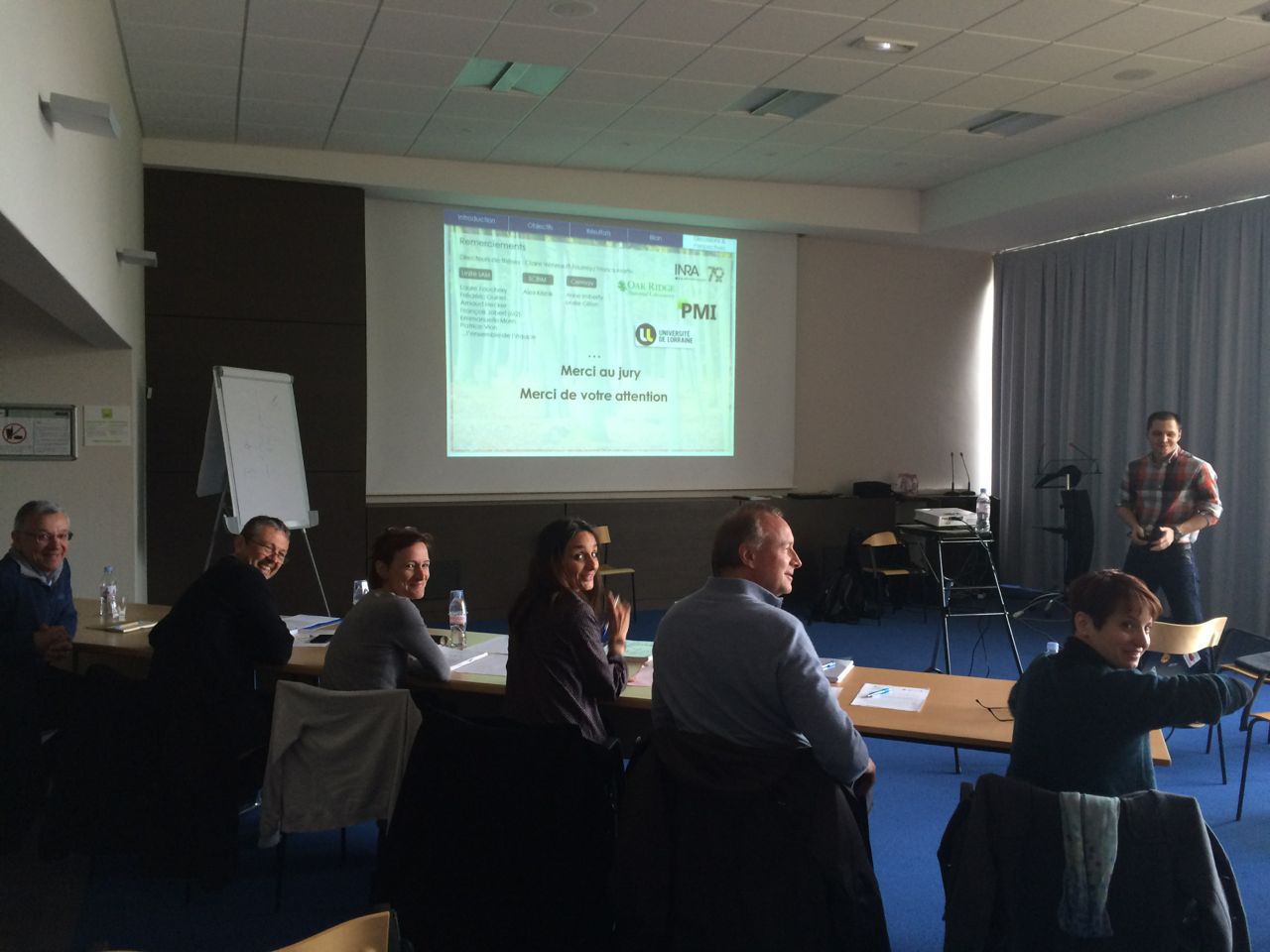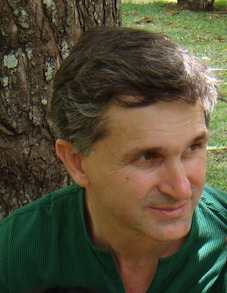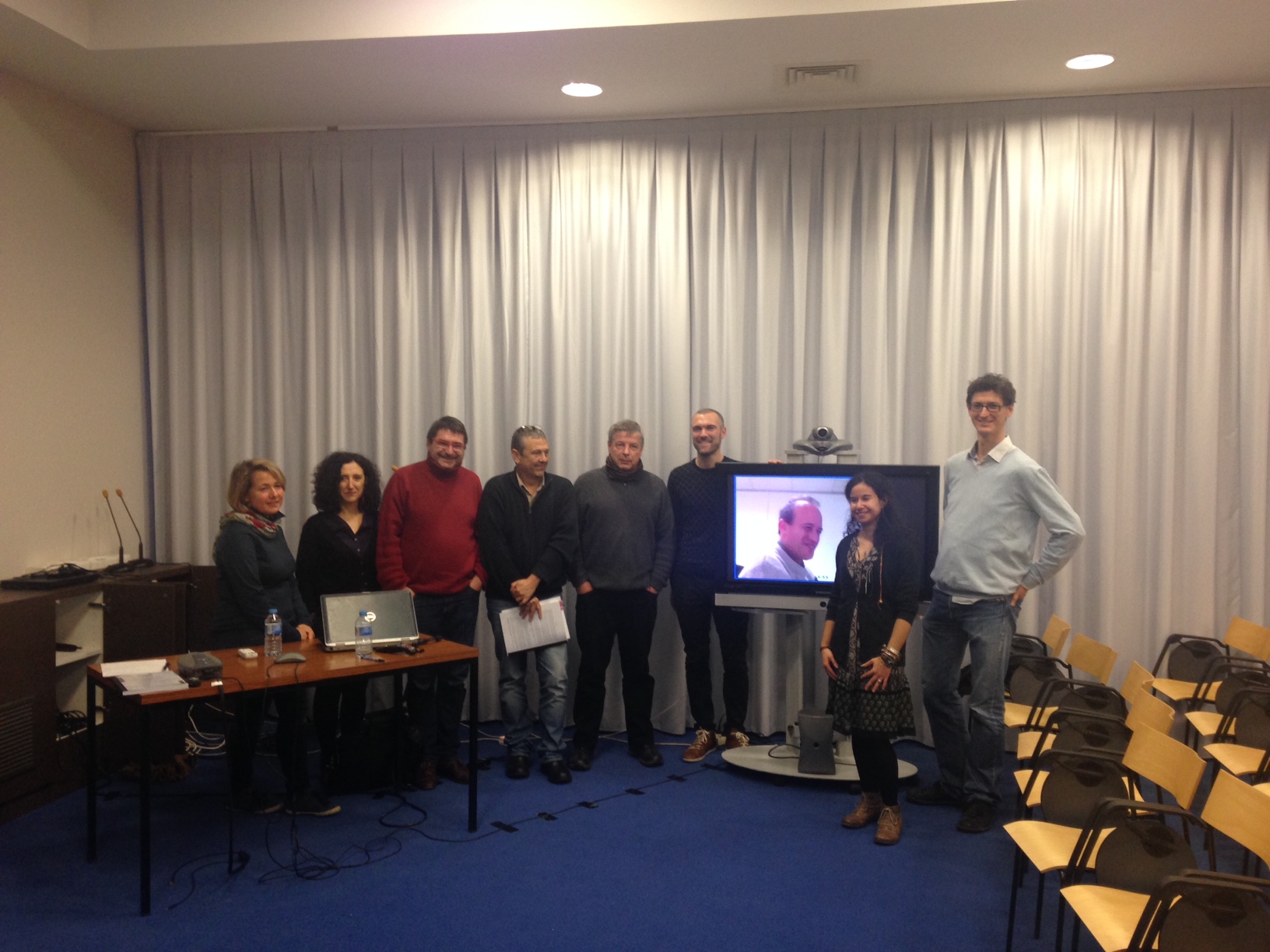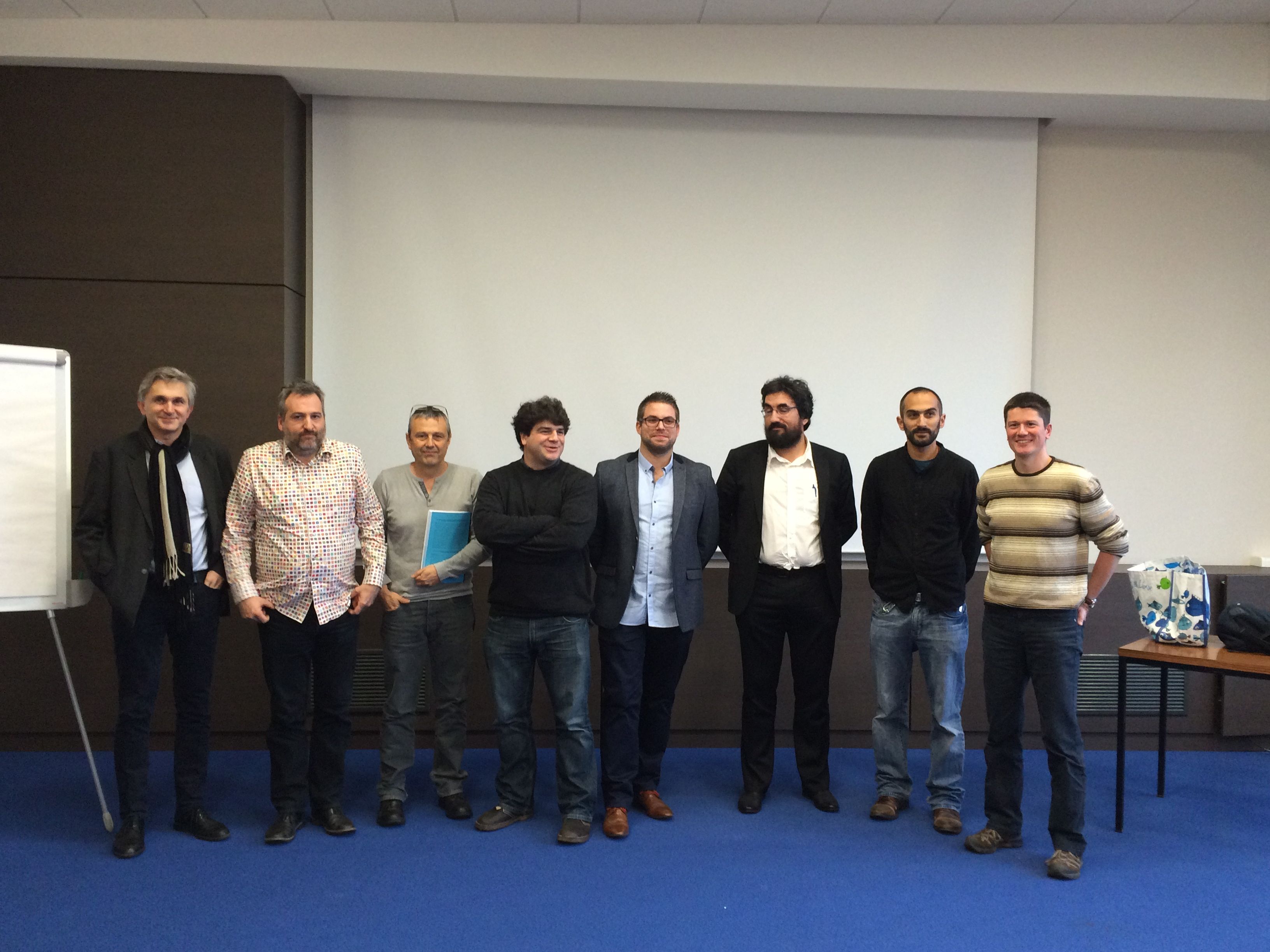The seminar of the week will be given by Marie Grosdidier who is currently doing her PhD in the team Ecology of Forest Pathogen. She will present her last results at 1.30pm in the seminar room of the main building at Champenoux.
Category Archives: Seminars/events
PhD Defense: C. Pellegrin
The defense will be held the 26th April at 9h00 in the conference room of the INRA campus at Champenoux.

Titre : Analyse d’effecteurs du champignon ectomycorhizien Laccaria bicolor : approches bio-informatiques et fonctionnelles
Résumé :
La symbiose ectomycorhizienne associe les racines d’un arbre aux hyphes d’un champignon, conduisant à un échange réciproque de nutriments entre les deux partenaires. La colonisation fongique massive du cortex racinaire est caractérisée par la formation d’une interface symbiotique, le réseau de Hartig. Le fonctionnement de cette interface symbiotique n’est pas parfaitement élucidé mais l’acquisition du génome du symbionte ectomycorhizien Laccaria bicolor a permis d’identifier des petites protéines prédites sécrétées, les MiSSPs (Mycorrhiza-induced Small Secreted Proteins). Mon projet de thèse avait pour objectifs la comparaison des sécrétomes, notamment les petites protéines sécrétées (SSPs), de champignons ectomycorhiziens et saprotrophes, la localisation subcellulaire in planta et l’analyse fonctionnelle de MiSSPs de L. bicolor. L’analyse bioinformatique a notamment permis de révéler des clusters de SSPs fortement conservées entre champignons ectomycorhiziens et saprotrophes ou spécifiques de champignons ectomycorhiziens, mettant en lumière que les champignons ectomycorhiziens partagent des SSPs avec leurs ancêtres saprotrophes mais possèdent aussi d’autres SSPs spécifiques à leur mode de vie.
Un jeu de MiSSPs de L. bicolor appartenant à un « core-regulon » ont été localisées in planta, montrant que trois d’entre eux sont capables de cibler spécifiquement des compartiments subcellulaires de la cellule végétale. La recherche d’interactant pour l’effecteur candidat MiSSP8 n’a pas permis l’identification d’un interactant, mais le motif répété DWRR présent dans la séquence de MiSSP8 est unique aux champignons et est partagé par une famille de protéine fongique de champignons majoritairement saprotrophes. Ces résultats suggèrent que l’utilisation de SSPs comme moyen de communication est générique chez les champignons et démontrent aussi qu’au moins une petite protéine sécrétée requise pour la symbiose de L. bicolor a évoluée à partir de protéines de champignons saprotrophes.
Abstract :
Roots of most trees form ectomycorrhizal (ECM) symbiosis with mutualistic soil-borne fungi, relying on a bi-directional exchange of nutrients between the two partners. Fungal colonization of cortical root cells form the Hartig net, a symbiotic interface. Functioning of this symbiotic interface is not well known. However, Laccaria bicolor genome sequencing sheds the light on upregulated small-secreted proteins, so-called MiSSPs (Mycorrhiza-Small Secreted Proteins). Several L. bicolor MiSSPs were demonstrated as symbiosis effectors. My PhD project aims to compare secretomes, in particular SSPs, of fungal with different lifestyles and pursue functional analysis of MiSSPs of L. bicolor.
Based on the clustering analysis, we identified clusters of SSPs shared between saprotrophic and ECM fungi and clusters of SSPs specific to ECM-fungi. This study highlights that ECM fungi share SSPs with their saprotrophic ancestors but also possess lifestyle specific SSPs.
In planta subcellular localization of a set of MiSSPs belonging to a core-regulon showed that three of them are able to target different plant subcellular compartments. Functional analysis of the symbiosis effector MiSSP8 does not lead to the identification of a putative interactor but the repetitive motif DWRR of MiSSP8 protein sequence is unique to fungi and is shared with SSPs from saprotrophic ancestors. Our results suggest the use of SSPs as mean of communication is common and generic and show at least one SSPs required for ectomycorhizal symbiosis of L. bicolor has evolved from SSPs found in saprotrophic fungi.
Seminar : F. Zhang
in the ectomycorrhizal fungus Laccaria bicolor »
Seminar: Leticia Pérez Izquierdo
Seminar: David Barker
Seminar: Martin Lascoux
Pr. Martin Lascoux, Professor at the Department of Ecology and Genetics, Uppsala University (Sweden) will be at INRA-Nancy on Dec 15th for the PhD dissertation of Antoine Persoons. He will give a seminar in the conference room of INRA Nancy at 10:00 am on the following topic:
“Clinal variation and the genetic basis of adaptive traits in trees”
Here is an abstract of his seminar:
Identifying the loci underlying the variation in quantitative traits and detecting the selection acting on them remains, to this day, one of the main challenges in biology. Genome wide association studies (GWAS) have become the main approach to identify the genetic factors controlling complex traits. Limitations of GWAS have, however, started to become evident and different strategies have been offered to alleviate those. In particular, GWAS have limited power unless very large datasets are used. They therefore remain prohibitively expensive, and often not so informative, for non-model organisms with limited or nascent genome resources such as forest trees. So, at least in the short term, a more targeted strategy, combining common gardens, population genetics, physiological and expression studies of candidate genes remains a very fruitful alternative. We will illustrate this with recent studies of clinal variation in phenological traits in forest trees, with special focus on boreal conifers, oaks and poplars. Some general features emerge from these different studies: first, they confirm the presence of strong latitudinal clines in phenological traits such as growth cessation. Second, most of the studies highlight the importance of genes belonging to the photoperiodic pathway and the circadian clock in the control of growth cessation. For instance, in both Norway and Siberian spruces, FTL2, a homolog of the main integrators for flowering time in A. thaliana, exhibits evidence of local adaptation and significant latitudinal variation in expression. Finally, the study of parallel clines in phenological traits, offers a first glimpse at the importance of parallel or convergent evolution in forest trees. They thereby provide us with a bit of information on the genetic architecture of important adaptive traits.
Please join us for this seminar.
PhD Defense: H. Pegeot
The defense will be held the 11th December at 14h00 in Amphitheater 7, Faculté des Sciences, Boulevard des Aiguillettes, Vandoeuvre.
Etude des glutathion transférases de la classe Phi du peuplier (Populus trichocarpa) : caractérisation structurale, enzymatique et recherche de molécules cibles.
Résumé : Les glutathion transférases (GSTs) constituent une famille multigénique d’enzymes présentes dans les trois domaines du vivant. Cette présence ubiquitaire souligne l’origine sans doute très ancienne de ces enzymes ainsi que des fonctions fondamentales conservées au cours de l’évolution. Ces enzymes sont impliquées notamment dans la détoxication cellulaire de molécules toxiques et dans le métabolisme secondaire. Les analyses phylogénétiques regroupent les GSTs des organismes photosynthétiques au sein de quatorze classes qui peuvent être séparées en deux grands groupes selon le résidu catalytique : les GSTs à sérine catalytique qui possèdent des activités de conjugaison du glutathion (GSH) et/ou peroxydase tandis que les GSTs à cystéine catalytique présentent des activités thioltransférase, déshydroascorbate réductase et de déglutathionylation. Les GSTs à sérine catalytique de la classe Phi (GSTF) sont présentes chez les organismes photosynthétiques et certains basidiomycètes. Chez les plantes, cette classe comprend un nombre de gènes plus important que les autres classes de GSTs. Ceux-ci sont parmi les plus régulés en réponse à divers stress et ils ont été fortement étudiés chez les plantes céréalières en raison de l’activité de détoxication des herbicides des protéines correspondantes. Pourtant, à quelques exceptions près, les rôles physiologiques des GSTFs restent inconnus et la redondance d’isoformes dans cette classe reste incomprise. Par des approches moléculaires, biochimiques et structurales, l’analyse structure-fonction des huit GSTFs de l’arbre modèle Populus trichocarpa a été réalisée au cours de cette thèse. L’analyse phylogénétique des GSTFs chez les organismes photosynthétiques a montré que cette classe est apparue au moment de l’apparition terrestre des végétaux et que différents groupes pouvaient être identifiés avec des motifs catalytiques distincts. L’analyse transcriptionnelle a montré que les gènes relatifs aux GSTFs de peuplier sont principalement exprimés dans les fleurs femelles, les pétioles et les fruits. Certains aspects du mécanisme réactionnel ont été caractérisés en déterminant notamment les paramètres cinétiques et d’interaction des huit GSTFs et de plusieurs variants mutés pour des résidus clés vis-à-vis de substrats modèles. Les structures de cinq des huit GSTFs ont été résolues et ces protéines dimériques adoptent un repliement GST canonique et des spécificités structurales au niveau du site actif ont pu être observées. De plus, au regard de la capacité des orthologues des GSTFs à lier des hormones et des flavonoïdes ainsi que de l’expression récurrente des GSTFs de peuplier dans les fruits et les fleurs femelles, deux organes riches en ces molécules, il peut être supposé qu’elles ont aussi des propriétés de type ligandine. Des résultats préliminaires ont également été obtenus pour la recherche de substrats physiologiques à partir de métabolites extraits de différents organes de peuplier. A terme, l’identification de ces substrats permettra de déterminer le mode d’action (catalytique vs ligandine) de chaque enzyme et d’identifier clairement les fonctions in planta de ces enzymes.
Mots clés : glutathion transférase ; Populus trichocarpa ; Phi ; structures cristallographiques ; mécanismes enzymatiques ; recherche de substrats
Abstract: Glutathione transferases (GSTs) belong to a multigenic family whose presence in most eukaryotes, prokaryotes and archaea reflects their widespread nature and very likely important functions. These enzymes represent a major group of enzymes involved in xenobiotic detoxification and secondary metabolism. From the most recent genomic and phylogenetic analyses, the GST family is subdivided into 14 classes that can be separated into two main groups based on the catalytic residue which is either a serine (Ser-GST) or a cysteine (Cys-GST). Ser-GSTs usually catalyze glutathione (GSH) conjugation and/or peroxide reduction. On the other hand, Cys-GSTs cannot perform GSH-conjugation reactions but instead catalyze thiol-transferase, dehydroascorbate reductase and deglutathionylation reactions. Ser-GSTs from the Phi class (GSTF) are present in photosynthetic organisms and some basidiomycetes. This class is composed of a large number of genes compared to other GST classes which are amongst the most stress-inducible. The corresponding proteins have been extensively studied in crops with regard to their detoxification activities toward herbicides. However, with a few exceptions, very little is known about their roles in planta and it is not well understood why this class has expanded. By combining molecular, cellular, biochemical and structural approaches, the eight isoforms from the model tree Populus trichocarpa have been characterized during this PhD project. Phylogenetic analysis of GSTFs in the green lineage shows that the apparition of this class is concomitant with the appearance of terrestrial plants and that different groups can be distinguished based on the active site signature. RT-PCR analysis of the eight isoforms of GSTFs showed that transcripts mostly accumulate in female flowers, petioles and fruits. Some aspects of the reaction mechanism have been characterized by determining kinetic parameters of the eight poplar GSTFs and of several mutated variants for key residues towards model substrates. The structures of five GSTFs have been solved and these dimeric proteins display a typical GST fold but specificities have been observed at the catalytic site level. Moreover, considering the demonstrated capacity of GSTF orthologs to bind hormones, anthocyanins or flavonoids, and the consistent high expression of poplar GSTFs in female flowers and fruits, two organs rich in these molecules, we speculate that they may also possess ligandin properties. Preliminary results have been obtained regarding the nature of the substrates in various poplar organs by analyzing protein thermostability in the presence of putative ligands. In order to assess whether a functional redundancy between poplar Phi GSTs exists and to identify their mode of action (catalytic vs ligandin functions), we started to isolate and identify physiological substrates.
Key words: Glutathione transferase; Populus trichocarpa; Phi; crystal structures; enzymatic mechanisms; research of substrates.
PhD Defense: Emila Akroume
“Élaboration d’un dispositif expérimental de manipulations de matière organique sur le long terme en forêt tempérée et évaluation des impacts à très court terme des exportations sur le sol.”
La soutenance aura lieu le vendredi 11 décembre 2015 à 13h30 dans la salle de conférence du centre INRA de Champenoux. Vous serez toutes et tous les bienvenus au pot qui suivra la soutenance.
Composition du jury:
M. Jean-Paul LACLAU, DR, UMR Eco & Sol, CIRAD Montpellier, Rapporteur
Mme Ana RINCÓN, Chercheur senior, Departamento de protección vegetal, ICA-CSIC Madrid,Rapporteur
M. Lauric CECILLON, CR, UR EMGR, IRSTEA Grenoble, Examinateur
Mme Christine DELEUZE, Chargée de R&D, ONF RDI, Pôle de Dôle, Examinateur
M. Eric GELHAYE, Pr, UMR IAM, Université de Lorraine, Examinateur
M. Marc BUEE, DR, UMR IAM, INRA Nancy, Directeur de thèse
M. Laurent SAINT-ANDRE, DR, UR BEF, INRA Nancy, Directeur de thèse
M. Bernhard ZELLER, IR, UR BEF, INRA Nancy, Directeur de thèse
Résumé
Les rémanents de coupe constituent une ressource non exploitée potentiellement utilisable à des fins énergétiques, mais aussi un compartiment essentiel pour la fertilité et la biodiversité des sols forestiers. Des études en zones tropicales ou boréales prouvent les impacts négatifs de telles pratiques sur les écosystèmes forestiers. Le réseau Matières Organiques des Sols (MOS) a été élaboré afin d’évaluer les effets à court et long terme des manipulations de matière organique sur les peuplements forestiers tempérés.Cette thèse a deux objectifs : i) élaborer la méthodologie nécessaire pour caractériser la variabilité des écosystèmes puis mettre en œuvre le dispositif expérimental national de manipulations de matière organique en tenant compte de cette variabilité et ii) décrire les impacts à très court terme des prélèvements de biomasse sur le fonctionnement des sols forestiers. Ce second objectif s’articule en deux volets: une première partie vise à évaluer l’impact de ces pratiques sylvicoles sur l’équilibre des cycles biogéochimiques et la diversité des communautés fongiques du sol in situ. Une seconde échelle d’étude, en conditions contrôlées, concerne le décryptage des interactions trophiques entre l’arbre, les champignons ectomycorhiziens associés, et les champignons lignivores au cours de la dégradation du bois. Ce premier suivi des sites du réseau MOS nous renseigne sur la réactivité à très court terme des sols forestiers en zone tempérée. L’absence de tendance claire confirme une préservation de l’équilibre des cycles sur un faible laps de temps mais permet de dégager des indicateurs fonctionnels qui semblent répondre rapidement aux perturbations. Un suivi annuel consolidera ces observations sur l’ensemble du dispositif MOS, incluant les indicateurs biologiques qui pourront être mis en évidence sur les communautés fongiques.
Abstract
Logging residues represent a non-exploited supply which could be used for energetic purpose, but they are also a relevant compartment for forest soil fertility and biodiversity. Some studies in tropical and boreal context have highlighted the negative impacts of these practices on the forest ecosystems. The MOS network has been set up to evaluate the effects of organic matters manipulations on temperate forest stands at short and long term.This thesis has two objectives: i) to set up the methodology necessary to characterized the ecosystems’ variability and then, to implement the national experimental design of organic matter manipulation by taking into account this variability and ii) to describe the very short terms impacts of organic matter removal on the forest soil cycling. This second aim is organized into two axes: a first part evaluates the impacts of these sylvicultural practices on the biogeochemical cycles and the diversity of fungal communities. A second study ! scale, in controlled conditions, deals with the understanding of the trophic interactions between trees, ectomycorrhizal fungi and saprotrophic fungi during the wood decaying process.The absence of clear trend confirms the persistence in the soil functioning at very short term. This first monitoring permitted to identify some functional indicators. A regular monitoring will strengthen these observations by introducing some biological indicators on fungal communities.
PhD Defense: Antoine Persoons
Les contournements de résistance par Melampsora larici-populina, l’agent de la rouille du peuplier : impact démographique et déterminisme génétique
Jury de thèse :
Martin LASCOUX Professeur, Université d’Uppsala, Rapporteur
Christophe LEMAIRE, Maitre de Conférence, Université d’Angers, Rapporteur
Éric GELHAYE, Professeur, Université de Lorraine, Examinateur
Pierre GLADIEUX, Chargé de recherche, INRA Montpellier, Examinateur
Sébastien DUPLESSIS, Directeur de recherche, INRA Nancy, Directeur de thèse
Stéphane DE MITA, Chargé de recherche, INRA Nancy, Co-Directeur
Membre invité : Fabien HALKETT, Chargé de recherche, INRA Nancy, Co-Directeur
Mots clés: champignon phytopathogène, coévolution, génétique des populations, scan génomiqueAbstract: Melampsora larici-populina is a pathogenic fungus responsible of poplar leaf rust, causing severe damages in plantations worldwide. Almost all poplar resistances deployed so far in France have been overcome and a major event that occurred in 1994 with the breakdown of resistance R7 mostly used in poplar cultivation. In order to identify candidate genes linked to pathogenicity, I conducted a comparative genomics study based on the sequencing of 15 isolates. This analysis revealed polymorphism patterns correlated to the distribution of virulences among isolates while the necessity of a population genetics study. I then analyzed the genetic structure of a comprehensive collection of 600 isolates of M. larici-populina sampled from 1992 to 2012. This analysis demonstrated the major impact of the R7 breakdown on populations. Finally, I conducted a population genomics analysis to obtain a demographic scenario describing the historical links between populations and to identify genomic regions under selection. This analysis is based on the Illumina sequencing of 86 isolates in four key populations identified by the population genetic analysis. Over 1,000,000 polymorphic positions were identified. The best demographic scenario was assessed using Approximate Bayesian Computation algorithms based on coalescent simulations. Using this demographic scenario, I computed the confidence interval of several population genetic indices. This genome scan analysis was performed on the 86 genomes using this same indices and revealed 20 genomic regions containing 14 avirulence 7 candidate genes.
Key words: phytopathogenetic fungus, coevolution, population genetics, genome scan
Seminar : F. Maillard
François Maillard, qui débute sa thèse de Doctorat dans notre unité, nous présentera ses travaux de Master (travaux réalisés dans l’équipe de Michel Chalot) ce vendredi 30 octobre (salle LEGF, 13h30) :
” Les communautés microbiennes associées au peuplier dans un contexte de phytostabilisation “



